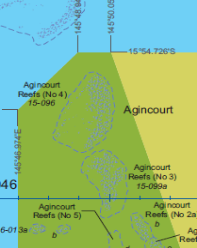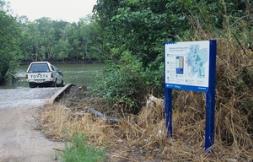


Les limites de la zone peuvent être décrites comme une distance spécifiée à partir du bord d'un élément géographique (par exemple, "500 m du bord du récif"). Il en résulte normalement une limite de zone de forme irrégulière. La représentation d'un récif ou d'un groupe de récifs de cette manière peut sembler écologiquement appropriée sur une carte, mais l'utilisation du bord de ces caractéristiques pour tracer les limites de la zone s'est avérée très difficile à interpréter sur l'eau. Par exemple, de nombreuses parties de récifs sont fragmentées ou parfois submergées, de sorte qu'il est difficile sur l'eau de déterminer le bord du récif, puis de l'utiliser pour estimer une distance. En outre, il n'est pas facile d'estimer 500 m (ou même 100 m) sur l'eau. Les limites des zones basées sur les coordonnées, basées sur la longitude/latitude et indiquées en degrés et minutes décimales, ont donc été introduites dans le plan de zonage de la GBR de 2003. Elles englobent entièrement les caractéristiques écologiques (c'est-à-dire bien au-delà du bord des récifs/îles entiers). Les limites des zones sont orientées vers le nord, le sud, l'est et l'ouest pour faciliter la navigation ou sont constituées de lignes droites entre deux coordonnées faciles à déterminer. Les lignes droites semblent moins "écologiquement appropriées", mais elles sont plus faciles à localiser et à faire respecter dans les zones offshore, en particulier si l'on utilise des appareils électroniques tels qu'un système de positionnement global (GPS) ou une table traçante.
En s'appuyant sur le zonage existant, il est important que chaque zone ait un numéro unique, renvoyant à une description détaillée dans le plan de zonage statutaire (voir Ressources) et avec un identifiant de zone unique (par exemple MNP-11-031) : a) MNP fait référence au type de zone (Marine National Park Zone) b) les deux premiers chiffres font référence à sa latitude (l'exemple montré ci-dessus est à la latitude 11°) c) le dernier chiffre (031) permet d'identifier une zone spécifique sur les cartes de zonage et de faire référence au plan de zonage.
- Toutes les coordonnées des zones ne sont pas indiquées sur les cartes de zonage librement accessibles ; toutefois, les coordonnées des zones les plus importantes pour la plupart des utilisateurs sont indiquées (par exemple, les zones d'interdiction de pêche et les zones d'interdiction d'accès).
- Sachant que tout le monde ne dispose pas d'un GPS, les limites des zones côtières sont alignées sur des caractéristiques côtières reconnaissables ou sur des points de repère ou des bornes identifiables (par exemple, "la zone s'étend au nord de l'extrémité orientale du promontoire de xxx").
- Des panneaux indiquant les zones proches sont placés sur les rampes de mise à l'eau le long de la côte (voir les photos ci-dessous).
- Toutes les coordonnées des zones sont communiquées aux fournisseurs commerciaux d'aides électroniques à la navigation, ce qui permet de charger les zones dans un GPS.
- En outre, toutes les coordonnées des zones sont disponibles gratuitement sur le web ou sur CD pour permettre à tout utilisateur de reporter les coordonnées sur sa propre carte de navigation ou de localiser une zone à l'aide de son propre GPS.
- Toutes les coordonnées doivent être référencées par rapport à un système de référence géocentrique officiel spécifié pour plus de précision (par exemple GDA94 en Australie).